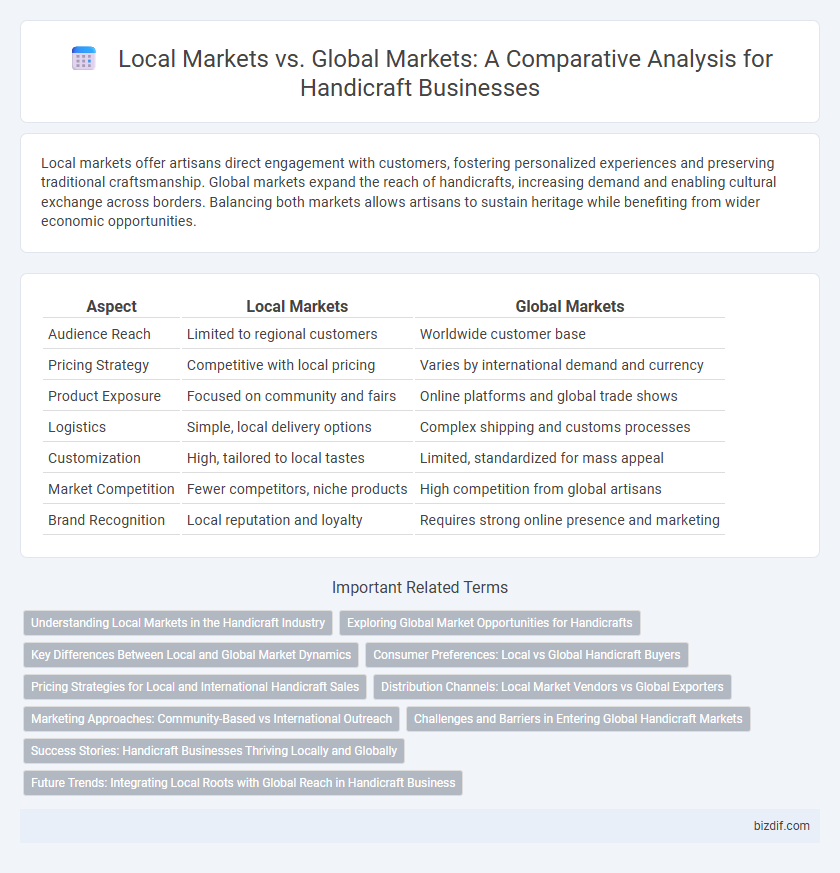Local markets offer artisans direct engagement with customers, fostering personalized experiences and preserving traditional craftsmanship. Global markets expand the reach of handicrafts, increasing demand and enabling cultural exchange across borders. Balancing both markets allows artisans to sustain heritage while benefiting from wider economic opportunities.
Table of Comparison
| Aspect | Local Markets | Global Markets |
|---|---|---|
| Audience Reach | Limited to regional customers | Worldwide customer base |
| Pricing Strategy | Competitive with local pricing | Varies by international demand and currency |
| Product Exposure | Focused on community and fairs | Online platforms and global trade shows |
| Logistics | Simple, local delivery options | Complex shipping and customs processes |
| Customization | High, tailored to local tastes | Limited, standardized for mass appeal |
| Market Competition | Fewer competitors, niche products | High competition from global artisans |
| Brand Recognition | Local reputation and loyalty | Requires strong online presence and marketing |
Understanding Local Markets in the Handicraft Industry
Local markets in the handicraft industry often prioritize cultural authenticity, unique craftsmanship, and personalized customer interactions, which drive consumer loyalty and demand for traditional products. Understanding regional preferences, seasonal trends, and community values enables artisans to tailor their designs and pricing effectively, enhancing market relevance. Strong local connections and storytelling behind each piece foster trust and support sustainable growth within these niche markets.
Exploring Global Market Opportunities for Handicrafts
Exploring global market opportunities for handicrafts unlocks access to diverse consumer bases seeking authentic, culturally rich products. Leveraging e-commerce platforms and international trade fairs enhances visibility and scalability for artisans beyond local markets. Understanding global trends and consumer preferences enables strategic positioning of handicrafts, driving sustainable growth and preserving traditional craftsmanship worldwide.
Key Differences Between Local and Global Market Dynamics
Local markets in handicraft prioritize personalized customer interactions, regional cultural influences, and limited production scale which fosters unique, artisanal products. Global markets emphasize mass distribution, diverse consumer preferences, and streamlined supply chains to achieve economies of scale and wider brand recognition. Pricing strategies in local markets reflect niche demand and handcrafted quality, whereas global markets often focus on competitive pricing driven by large-scale production and international competition.
Consumer Preferences: Local vs Global Handicraft Buyers
Local handicraft buyers prioritize authenticity, cultural significance, and traditional craftsmanship, often favoring unique, handmade items reflective of regional heritage. Global markets demand broader appeal, emphasizing diverse styles, scalable production, and contemporary aesthetics to cater to varying international tastes. Consumer preferences thus shape product design, marketing strategies, and distribution channels in local versus global handicraft trade.
Pricing Strategies for Local and International Handicraft Sales
Pricing strategies for local handicraft markets emphasize affordability and cultural value to attract community-based customers, often taking into account lower overhead costs and local purchasing power. In contrast, international handicraft sales implement premium pricing to reflect uniqueness, craftsmanship, and shipping expenses, targeting niche buyers willing to pay higher prices for authentic, artisanal products. Strategic price differentiation supports sustainable income for artisans while catering to diverse consumer segments across local and global marketplaces.
Distribution Channels: Local Market Vendors vs Global Exporters
Local market vendors in handicraft rely on direct sales through artisan fairs, community shops, and street markets, enabling quick feedback and personalized customer relationships. In contrast, global exporters utilize complex distribution channels including online platforms, international trade shows, and bulk shipments through logistics networks to reach diverse global consumers. Efficient coordination between production, quality control, and shipping is vital for exporters to meet international demand and comply with global trade regulations.
Marketing Approaches: Community-Based vs International Outreach
Local markets in handicraft prioritize community-based marketing approaches, emphasizing personal relationships, storytelling, and cultural authenticity to build trust and brand loyalty among nearby customers. In contrast, global markets leverage international outreach strategies such as digital platforms, social media campaigns, and collaborations with global influencers to expand visibility and attract diverse consumer bases. Effective handicraft marketing balances localized engagement with global exposure to maximize reach and sales potential.
Challenges and Barriers in Entering Global Handicraft Markets
Local handicraft markets often face challenges such as limited production capacity, lack of standardization, and restricted access to advanced logistics, which hinder scalability in global markets. Barriers in entering global handicraft markets include complex regulatory requirements, high export costs, and cultural differences that affect product acceptance. Overcoming language barriers and meeting international quality standards are crucial for artisans aiming to expand their reach beyond local boundaries.
Success Stories: Handicraft Businesses Thriving Locally and Globally
Handicraft businesses thrive by leveraging unique cultural heritage and craftsmanship, successfully tapping into both local markets where personalized, authentic products attract loyal customers, and global markets driven by e-commerce platforms expanding reach to international buyers. Companies such as India's Fabindia and Morocco's Souk Artisan demonstrate how blending traditional techniques with modern marketing strategies can create scalable, sustainable growth. These success stories highlight the importance of preserving artisanal quality while embracing digital tools to compete on a global stage.
Future Trends: Integrating Local Roots with Global Reach in Handicraft Business
Future trends in the handicraft business emphasize blending local roots with global reach by leveraging e-commerce platforms and digital marketing to expand market access. Artisans are increasingly adopting sustainable practices and authentic storytelling to appeal to conscious consumers worldwide. This integration fosters economic growth in local communities while meeting the demand for unique, culturally rich products in global markets.
Local Markets vs Global Markets Infographic

 bizdif.com
bizdif.com